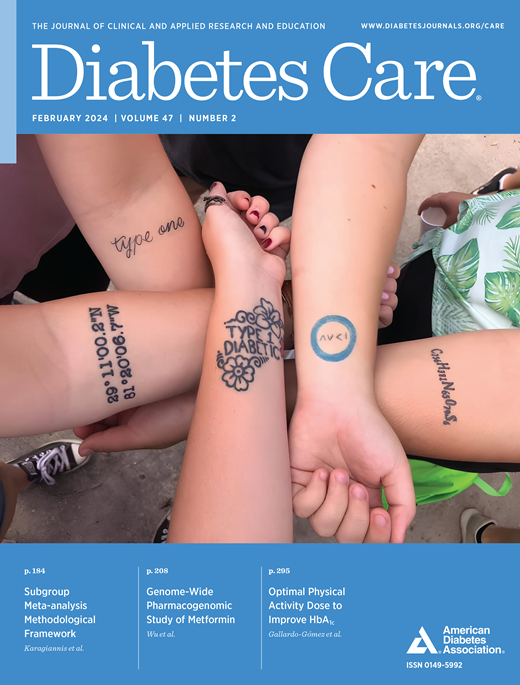Prediction of Weight Loss and Regain Based on Multiomic and Phenotypic Features: Results From a Calorie-Restricted Feeding Trial
IF 16.6
1区 医学
Q1 ENDOCRINOLOGY & METABOLISM
引用次数: 0
Abstract
OBJECTIVE To identify baseline multiomic and phenotypic predictors and develop prediction models for weight and body composition loss and regain in the Low-Carbohydrate Diet and Time-Restricted Eating (LEAN-TIME) trial. RESEARCH DESIGN AND METHODS A post hoc analysis was conducted of the LEAN-TIME feeding trial using data from 88 adults with overweight/obesity completing a 12-week calorie-restricted weight-loss phase and 79 completing a 28-week weight-regain phase. Baseline dietary, metabolic, fecal metabolome, and gut microbiome data were candidate predictors of changes in weight, body fat mass (BFM), and soft lean mass (SLM). Multivariable regression and the least absolute shrinkage and selection operator model were used to identify predictors and develop weighted-sum prediction models. RESULTS Multiomic and phenotypic models significantly outperformed phenotype-only models (P < 0.05), demonstrating strong predictive performance during both phases. During weight loss, the multiomic and phenotypic model yielded R2 values of 0.49, 0.61, and 0.54 for changes in weight, BFM, and SLM, respectively, with corresponding root mean square errors (RMSEs) of 1.59, 1.41, and 0.98 kg. For binary classification of clinically meaningful weight loss (≥5%), the model achieved an area under the curve of 0.95 (sensitivity 94.12%; specificity 86.79%). During weight regain, R2 values reached 0.72, 0.73, and 0.66 for weight, BFM, and SLM (RMSEs 1.40, 1.62, and 0.73 kg), respectively. Several key baseline predictors, primarily gut microbes and fecal metabolites, such as N-acetyl-l-aspartic acid, Ruminococcus callidus, and Bifidobacterium adolescentis, were shared for weight and body composition changes during both phases. CONCLUSIONS Baseline multiomic and phenotypic data effectively predict weight and body composition loss and regain, offering insights for personalized weight management.基于多组学和表型特征的体重减轻和恢复预测:来自热量限制喂养试验的结果
目的确定低碳水化合物饮食和限时饮食(LEAN-TIME)试验中体重和体成分损失和恢复的基线多组学和表型预测因子,并建立预测模型。研究设计和方法采用88名超重/肥胖成人完成12周热量限制减重阶段和79名完成28周体重恢复阶段的数据,对精益喂养试验进行了回顾性分析。基线饮食、代谢、粪便代谢组和肠道微生物组数据是体重、体脂质量(BFM)和软瘦质量(SLM)变化的候选预测因子。采用多变量回归、最小绝对收缩和选择算子模型识别预测因子,建立加权和预测模型。结果多组模型和表型模型显著优于单表型模型(P <;0.05),在这两个阶段都显示出较强的预测性能。在体重减轻过程中,多组和表型模型对体重、BFM和SLM变化的R2分别为0.49、0.61和0.54,相应的均方根误差(rmse)分别为1.59、1.41和0.98 kg。对于临床意义体重减轻(≥5%)的二元分类,该模型的曲线下面积为0.95(灵敏度94.12%;特异性86.79%)。体重恢复期间,体重、BFM和SLM的R2分别为0.72、0.73和0.66 (rmse分别为1.40、1.62和0.73 kg)。几个关键的基线预测因子,主要是肠道微生物和粪便代谢物,如n -乙酰-l-天冬氨酸、瘤球菌和青少年双歧杆菌,在两个阶段的体重和身体组成变化是相同的。结论基线多组学和表型数据可有效预测体重和体成分的损失和恢复,为个性化体重管理提供见解。
本文章由计算机程序翻译,如有差异,请以英文原文为准。
求助全文
约1分钟内获得全文
求助全文
来源期刊

Diabetes Care
医学-内分泌学与代谢
CiteScore
27.80
自引率
4.90%
发文量
449
审稿时长
1 months
期刊介绍:
The journal's overarching mission can be captured by the simple word "Care," reflecting its commitment to enhancing patient well-being. Diabetes Care aims to support better patient care by addressing the comprehensive needs of healthcare professionals dedicated to managing diabetes.
Diabetes Care serves as a valuable resource for healthcare practitioners, aiming to advance knowledge, foster research, and improve diabetes management. The journal publishes original research across various categories, including Clinical Care, Education, Nutrition, Psychosocial Research, Epidemiology, Health Services Research, Emerging Treatments and Technologies, Pathophysiology, Complications, and Cardiovascular and Metabolic Risk. Additionally, Diabetes Care features ADA statements, consensus reports, review articles, letters to the editor, and health/medical news, appealing to a diverse audience of physicians, researchers, psychologists, educators, and other healthcare professionals.
 求助内容:
求助内容: 应助结果提醒方式:
应助结果提醒方式:


